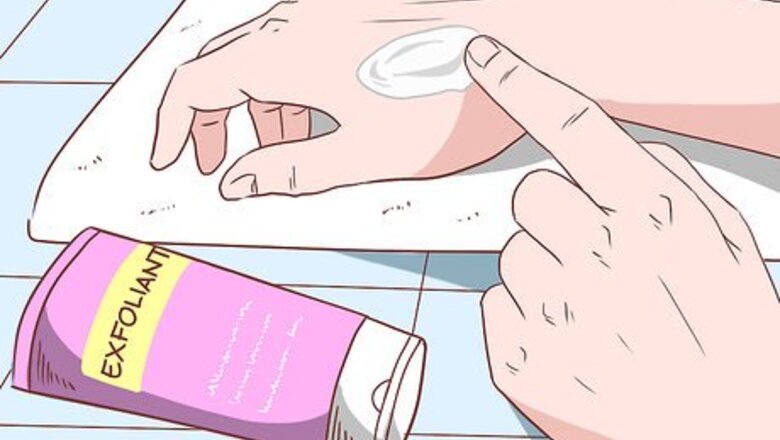
views
X
Trustworthy Source
American Academy of Dermatology
Professional organization made of over 20,000 certified dermatologists
Go to source
Treating Skin Directly
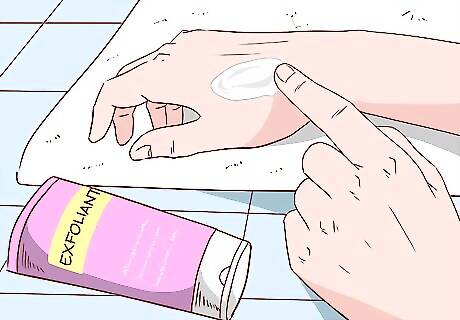
Exfoliate your skin once a week. Use a gentle exfoliant such as a body scrub, wash cloth, or dry brush. Manual exfoliation will scrub away dead skin cells, preventing clogged pores and keratin build-up that can lead to KP. Additionally, it stimulates cell renewal. Use a rough sponge to shower with to help slough off the dead skin. Avoid using a loofah though, as this may be too harsh. Shower with an exfoliating soap. Many are available that contain small beads that work to rub off skin. Use a sugar scrub. You can purchase these at many drugstores and beauty supply stores, or you can make your own. Mix sugar and honey to form a paste and then apply to your dry skin, rubbing in circles. Rinse with warm water afterwards. You can make your own exfoliant with table salt and olive oil. However, be careful not to slip while using it. Avoid anything too abrasive though, as this can cause damage to your skin in the long run.
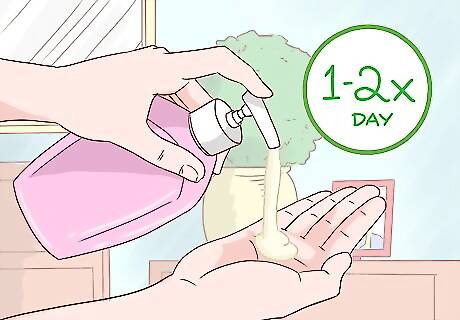
Use a moisturizer. The goal of treating keratosis pilaris is to soften the bumps. One of the best ways to do this is to apply a lotion or cream on a regular bases, one to two times a day. It's best to use chemical-free products like almond oil, jojoba oil, or coconut oil.
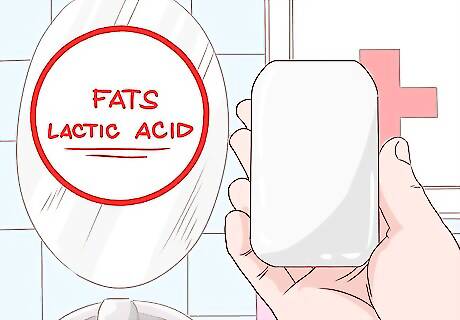
Try special soap, like Goat's milk or oatmeal. Oatmeal, when whole, is an exfoliant, and when used in soap it can soften skin. The fats and lactic acid in the goat's milk can help soften those pesky, scratchy bumps.

Use a moisturizer that contains lactic acid. Lactic acid has been proven to help break up the keratin that clogs up hair follicles, leaving those unsightly bumps. AmLactin and Lac-Hydrin are two brands that can be purchased without a prescription. Try topical retinoids. These are lotions that use derivations of vitamin A, which aids in dry skin. Look for Retin-A, Isotrex, or Differin at your local drugstore. Use urea cream, which breaks down dead skin and keratin. Be careful with this, however, as it can damage healthy skin if used too much. Always wash your hands directly after applying, and apply only as much as the directions instruct. Find a moisturizer that uses glycolic acid. This helps to dissolve the dead skin and buildup in the hair follicles. If you are unable to purchase a specialized brand of moisturizer for your bumps, look for mild lotions advertised for sensitive skin. Some ingredients in regular lotions can worsen your keratosis pilaris.
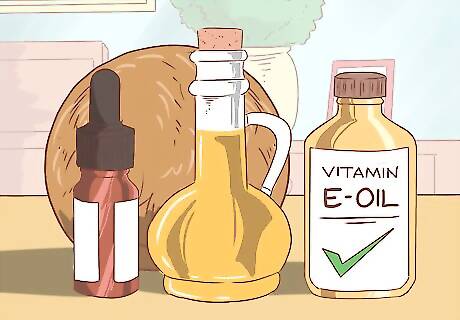
Use different oils on your skin. Similar to moisturizers and creams, oils work to soften skin and the keratin in it. Try rubbing a little oil once or twice a day on the affected area of your skin. Try using coconut oil. Although this may be found in the cooking section, it has shown to work wonders on softening skin. Use it in the shower for a few minutes, or dab it onto your dry skin before you to go to bed at night. Rubbing pure vitamin E oil on your dry skin can soften it while supplementing your skin with nutrients it may be lacking. Vitamin E has shown to have a strong connection to healthy skin and gives promising results in cases of keratosis pilaris. Sea Buckthorn is a type of plant that is made an oil used for skin ailments. Look for it at a local pharmacy or drugstore, and use it to rub onto your skin 1-2 times daily.
Treating Skin Indirectly
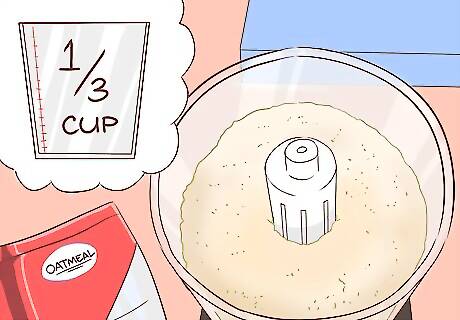
Take oatmeal baths. They will smooth and hydrate itchy skin. Do this at least once a week for maximum benefit. Take 1/3 cup oatmeal and blend in a blender until it's a fine powder. Pour into your warm bath as you run the water, to help mix it thoroughly. After your bath the oatmeal powder may be left in tub, especially if you did not blend enough. Don't worry, this isn't difficult to clean (unless you leave it in for days). Oatmeal baths can be bought in stores too if you would rather nix the extra work of blending it yourself.
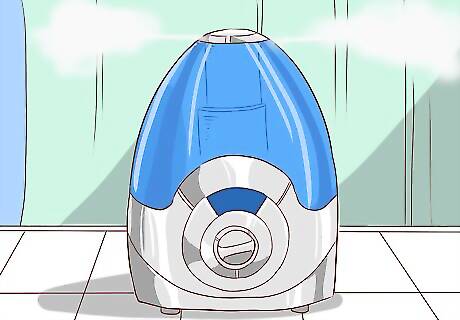
Use a humidifier. If you live in a dry area, your skin will be extra sensitive, and a humidifier can help. By adding moisture to the air, this basic machine can help your skin to stay soft. Using distilled water (pure water, no minerals, no contaminants) is recommended. Tap water contains lead, chlorine and nitrates, which is best to avoid whenever possible. If you don’t have your own humidifier, consider making your own using an old t-shirt and fan.
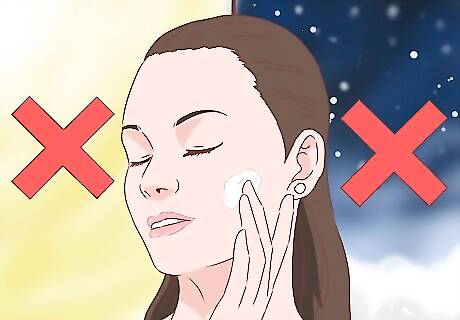
Avoid cold, dry weather. Low temperatures and humidity dry out skin, leaving it rough. For someone suffering with keratosis pilaris, this can aggravate your condition even more. If you live in a cool, dry area, make sure to moisturize daily.

Go out in the sun. Keratosis pilaris is typically less noticeable in the summer, which may have ties to being in the sun. Spend a little time outdoors to get the hormonal boost the sun provides while aiding your skin in clearing out dead cells. Always wear sunscreen when you spend time in the sun to avoid skin damage. There have been no official studies that prove sunlight improves keratosis pilaris, but there seems to be a correlation between the two. If nothing else, spending time in the sun has direct links to lessening depression and anxiety, which is good for everyone.

Avoid too much hot water. Taking extremely hot baths or showers can scald the skin and dry it out. When possible take warm or cool baths and showers to lessen the effect of the heat on your skin.

Get a prescription for retinol. Take a visit to your dermatologist to get a prescription for medication which may help your case. Your doctor may prescribe an ointment or cream, but each should make a difference in improving your skin.
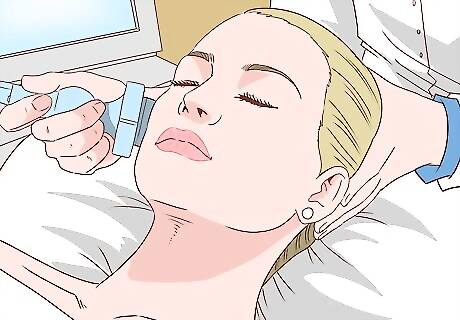
Try laser treatment. Although this is expensive and not beneficial in 100% of cases, getting laser treatment may help severe cases of keratosis pilaris. If you have been struggling for many years with your skin condition, this may be a viable option for you.












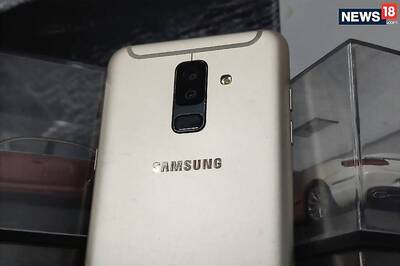




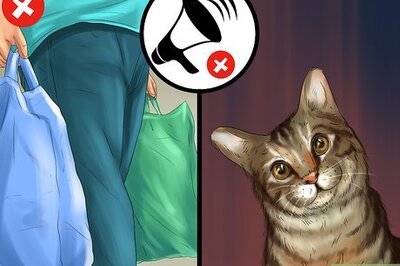
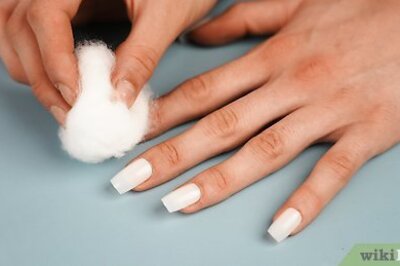

Comments
0 comment